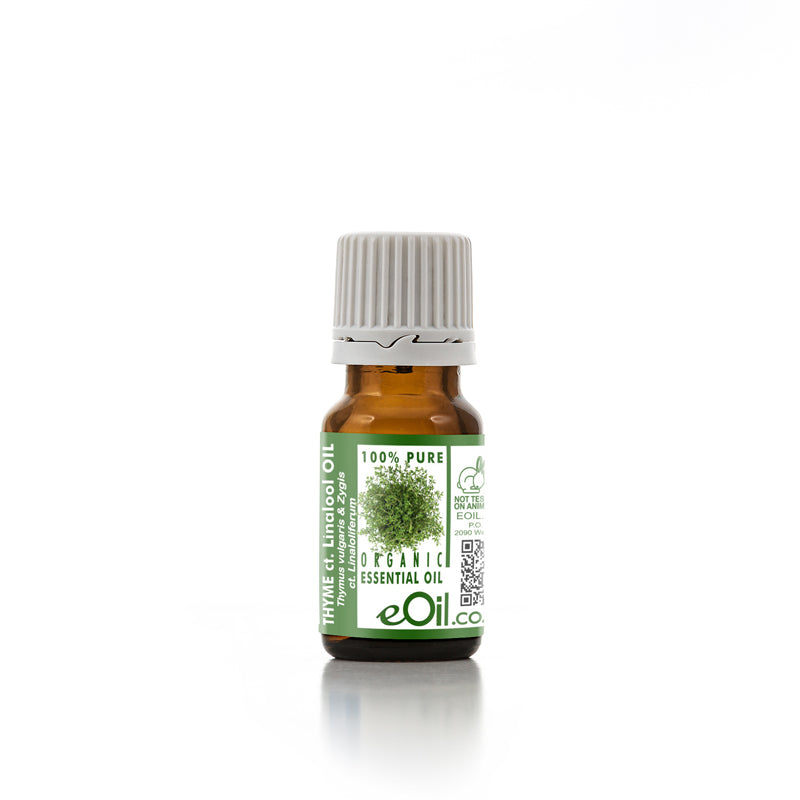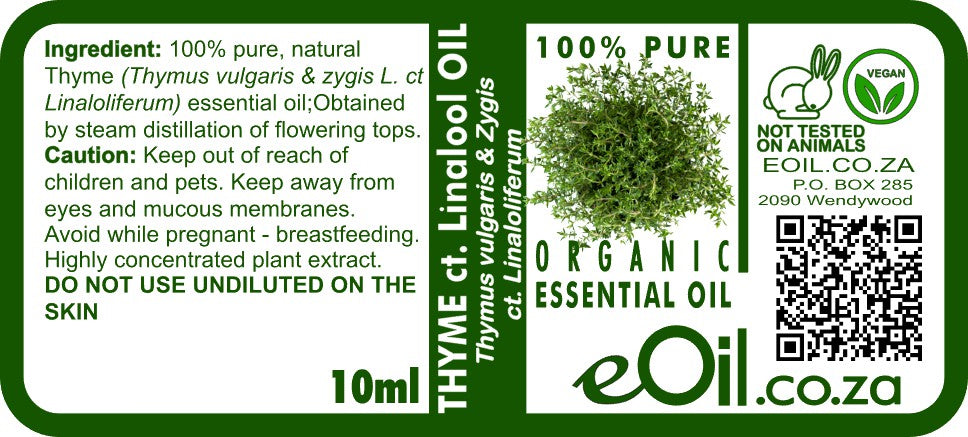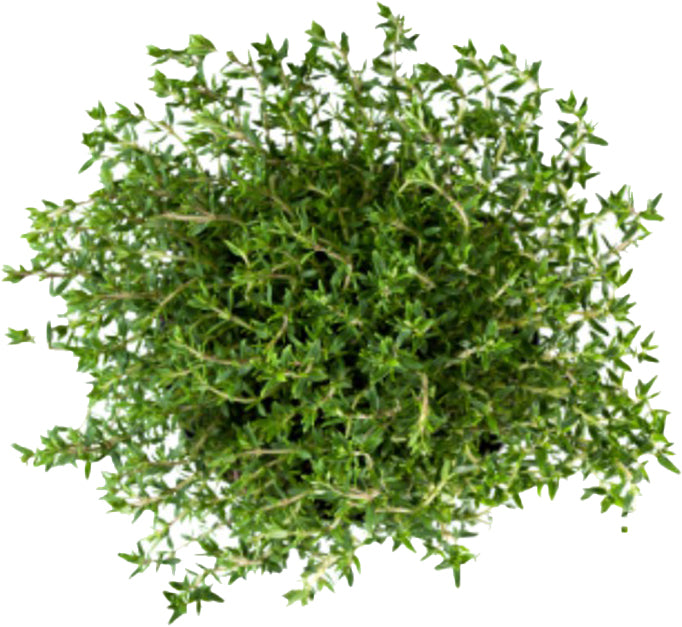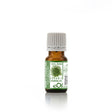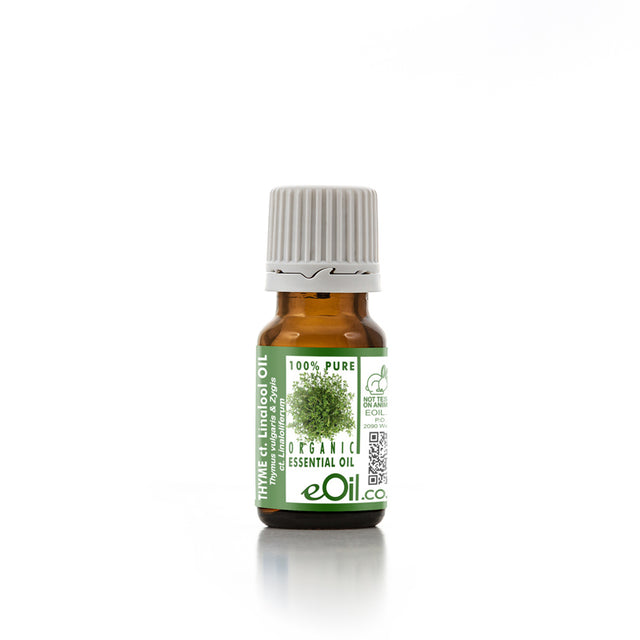Thyme Essential Oil Organic
Thyme Essential Oil Organic - 10 ml is backordered and will ship as soon as it is back in stock.
Description
Description
Thyme ct. linalool essential oil is steam-distilled from leaves and flowering tops of Thymus vulgaris, cultivated for its notably gentle, sweet-herbaceous scent and exceptional therapeutic versatility.
This chemotype is prized for its high linalool content, offering a milder, less irritating alternative to thymol- or carvacrol-rich thymes—excellent for sensitive users, children, and regular use.
IDENTIFICATION
INCI name ; Thymus Vulgaris Flower/Leaf Oil
CAS number ; 8007-46-3 ; 84929-51-1 ; 85085-75-2
SKU code ; EN-THR-0010
EXTRACTION METHOD ; Steam Distilled Essential Oil
PARTS USED ; Leaves and Tops
ORIGIN ; South Africa
COMMON NAMES : Common Thyme, German Thyme, Garden Thyme, English Thyme
APPEARANCE : Pale yellow to reddish brown colored liquid
ODOUR NOTE : Fresh, green, diffusive, sweet-herbaceous aroma
QUALITY : 100 % pure natural whole essential oil.
Active Ingredients : Linalool
STORAGE CONDITION ; Store in a cool dark place
THYMUS VULGARIS -
GROWN, HARVESTED AND DISTILLED IN SOUTH AFRICA
This is the gentler version Of Thyme essential oil.
If you are concerned about your sensitivity to thyme essential oil, this may be the one for you.
Both our Thyme Essential oils are powerful and efficient allies against mycoses, infectious viral or bacterial attacks, particularly of an ORL nature. They also help recover a healthy feminine hygiene and are perfect to diffuse when you feel nervously exhausted or weak.
* Our Thyme essential oil is steam distilled from the leaves and flowering tops of Thymus vulgaris, the common Thyme.
The 1rst distillation results in what is known as red thyme essential oil. Red brown, or orange brown in colour, with a sweet and spicy, herbal medicinal, scent.
To meet with therapists and food industry request for a gentler common thyme essential oil ((with reduced levels of thymol and carvacrol), the leaves and flowers are sometimes re-distilled. This 2nd distillation which leaves the oil colourless, is known as white thyme essential oil, and has softer, sweeter, and herbal scent.
TRADITIONALLY USED FOR
Traditionally used to improve:
- liver problems because it said to helps to regenerate liver cells (targeted massages)
- blood circulation. It warms the extremity (feet, fingers, …
- cases of fatigues, weakness, and nervous disorders. (diffusion and massages)
- All type of mycosis (targeted application)
- Air sanitation
- Throat pains, tracheitis, pharyngitis Bronchitis (diffusion)
- Blocked noses, colds, runny noses (diffusion)
- Cold sore (targeted application)
SOME RECIPES | SYNERGIES
White Thyme Essential Oil is derived from Thymus vulgaris, a perennial herb known for its medicinal properties. It goes through a distillation process and then is typically redistilled to remove certain elements, which results in a lighter color and scent. It is known for its purifying, stimulating and warming properties.
Red Thyme Essential Oil is also derived from Thymus vulgaris, but it's the first, unrectified distillate, which gives it a darker red color and a stronger, more herbaceous aroma. Red Thyme oil has powerful antimicrobial properties, but it's also more likely to cause skin irritation, so it should be used with extra caution.
Here are some recipes for each:
White Thyme Essential Oil Recipes
1. Invigorating Diffuser Blend:
- 3 drops of White Thyme essential oil
- 3 drops of Lemon essential oil
- 2 drops of Rosemary essential oil
Add the oils to your diffuser following the manufacturer's instructions. This blend can help to stimulate the mind and promote focus.
2. Purifying Room Spray:
- 1 cup of distilled water
- 10 drops of White Thyme essential oil
- 10 drops of Tea Tree essential oil
- 10 drops of Lavender essential oil
Combine all the ingredients in a spray bottle. Shake well before each use and lightly mist the room for a purifying effect.
3. Stimulating Bath Soak:
- 1 cup of Epsom salts
- 5 drops of White Thyme essential oil
- 5 drops of Peppermint essential oil
- 5 drops of Eucalyptus essential oil
Combine ingredients and store in a glass jar. Use 1/4 to 1/2 cup of the mixture in a warm bath for a stimulating and invigorating soak.
Red Thyme Essential Oil Recipes
1. Warming Diffuser Blend:
- 3 drops of Red Thyme essential oil
- 3 drops of Orange essential oil
- 2 drops of Cinnamon essential oil
Add these oils to your diffuser according to the manufacturer's instructions. Enjoy the warming and comforting aroma in your home or office.
2. Anti-Microbial Surface Cleaner:
- 1 cup of distilled water
- 1 cup of white vinegar
- 20 drops of Red Thyme essential oil
Combine all the ingredients in a spray bottle. Shake well before each use and spray on surfaces to clean. Wipe with a dry cloth.
3. Soothing Massage Oil:
- 2 tablespoons of Sweet Almond oil
- 5 drops of Red Thyme essential oil
- 5 drops of Lavender essential oil
- 5 drops of Frankincense essential oil
Combine the oils in a glass bottle. Use this blend for a soothing massage. Always do a patch test first to ensure there is no skin irritation.
As with any essential oil, it's always a good idea to do a patch test first to ensure there's no skin irritation, and to consult with a healthcare provider or aromatherapist if you have any concerns. Thyme essential oil, particularly Red Thyme, is potent and should not be ingested and should be used with care. It should also be avoided by pregnant or nursing women, and by those with high blood pressure or epilepsy.
INSTRUCTIONS OF USE
Fantastic for this use +++
Acceptable (suitable) for this use ++
Tolerable (not great for this use)+
Don't use for this purpose --
Massages & body care
- Body massage use 1 to 6 drops essential oil for 10 ml carrier oil (0.5 to 2 % concentration) +++
- Face care use 1 to 3 drops essential oil for 10 ml carrier or base (0.5 to 1 % concentration) ++
- Body & Hair care use 2 to 6 drops essential oil for 10 ml carrier or base (1 to 2 % concentration) ++
- Bath First mix 10 to 15 drops of essential oil with 20 ml vegetable glycerine or 1 cup of Epsom salts ++
- Mouth gargle ++
Diffusion
- Ultrasonic Diffusers for air purification, use 10 mn 3 times a day. +++
Others
- Cooking ++
- Homecare ++
For more detailed information, please go check this LINK TO Instructions of use essential oils page
Fresh or Dried, in concoctions, in poultices, brewed or fumigated, the uses and properties of the humble shrub of thyme have been recorded since the early days of our human history. The Greeks of the antiquity gave it its name, “perfume”, believing it bring courage and fortitude, they burned it in public rituals and ceremonies. The Egyptians priest used crushed thyme to embalm the departed. The Romans added thyme to their beauty routines, hot baths, to purify their home, to flavour and preserve their meat, cheeses, and wine.
DO NOT USE UNDILUTED and seek medical and specialist advise when in doubt
SEE OUR PAGE ON PRECAUTION - HOW TO USE ESSENTIAL OILS SAFELY
REPORTED BENEFITS & PROPERTIES
Reported benefits & properties:
- Powerful Antibacterial, antifungal, antiviral
- Immunity stimulant
- Skin and body regenerating and stimulant
- Circulatory, warming
- Calming, Relaxing
BLEND WELL WITH
- Bay leaf laurel, ( mouth wash, gargle, or rinse -mouth sores and ulcers),
- Eucalyptus smithii, Ravintsara, (diffusion in case of colds, bronchitis and respiratory ailments)
- lemon, tea tree, Pine, lemongrass, ( Air sanitation),
- lavender ( skin regeneration),
- Pine, Eucalyptus, Bergamot (to boost and balance moods when exhausted)
CAUTION
Do not use during the first 3 months of pregnancy / breastfeeding
Keep out of reach of children and pets.
As a general rule, always perform a skin patch test before using your essential oils for the first time.
Due to the natural origin of our products, some ingredients may contain trace proteins or allergens, especially in unrefined oils.
We strongly recommend performing a patch test on a small skin area 48 hours before full use to check for sensitivities.
Always dilute essential oils appropriately and follow our recommended usage guidelines to ensure safe application.
If you experience any irritation or allergic reaction, discontinue use immediately and consult a healthcare professional
For more detailed information, please go check this LINK TO Instructions of use essential oils page
DO NOT USE UNDILUTED and SEEK MEDICAL AND SPECIALIST ADVISE WHEN IN DOUBT.
SEE OUR PAGE ON PRECAUTION - HOW TO USE ESSENTIAL OILS SAFELY

Thyme Essential Oil Organic - 10 ml is backordered and will ship as soon as it is back in stock.

